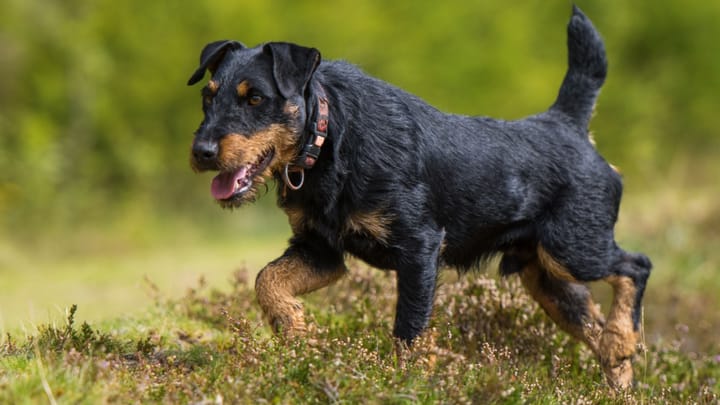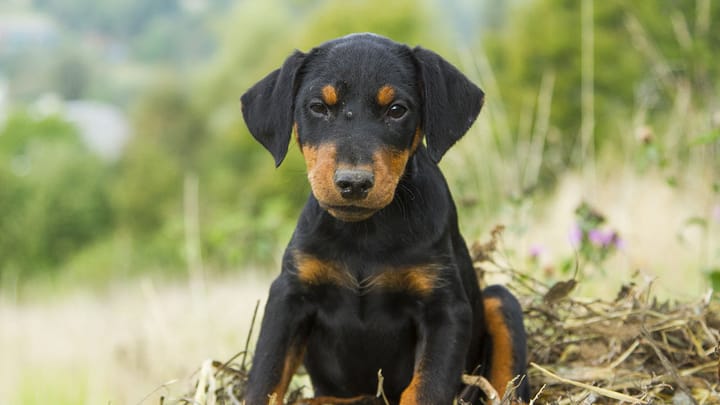German Hunting Terrier
Other names : Jagdterrier, Deutscher Jagdterrier, German Jagdterrier, German Hunt Terrier


This mid-sized German terrier is an accomplished hunter in an efficient, handsome black-and-tan package. His small, dark, deep eyes add an inscrutable sense of mystery while his scissor-bite jaw is neat and impressive. Developed between the wars by a team of German cynologists, hunters, and medical men looking to develop the ultimate hunting dog, his shadowy past does not preclude an affable presence on the dog scene today. A loner, he does not appreciate the company of other dogs, and is best suited only to families with a lively lifestyle and relatively low affection needs.
|
Life expectancy |
The German Hunting Terrier has a life expectancy of between 14 and 16 years |
|
Temperament |
|
|
Size |
Small
|
|
Adult size |
Female
Between 13 and 16 in
Male
Between 13 and 16 in
|
|
Adult weight |
Female
Between 15 and 18 lb
Male
Between 20 and 22 lb
|
|
Coat colour
|
Black Brown Blue |
|
Type of coat
|
Short Hard |
|
Eye colour
|
Brown
|
|
Purchase price |
The German Hunting Terrier costs approximately 425£ |
It’s pronounced ‘yack-terrier.’
Even when he is injured, he won’t necessarily show it because he is not very sensitive to pain. Regular inspection is essential.
More details about the German Hunting Terrier
German Hunting Terrier: Origins and history
If you’ve noticed that the Jagdterrier doesn’t like to talk about his past, it’s because there are skeletons in his closet – and that’s not just his bone collection. Terriers were ‘big’ in the 1920s, but there was no German terrier of note, so two German brothers - Lutz and Heinz Heck – decided to create one, the master terrier if you will, out of national pride. They used their connections in the Nazi party to find sponsors and collaborators for their project, and then had their team boil up a mix of Welsh Terrier, Old English Terrier, and Fox Terrier, with a sprinkle of Pinscher and Dachshund for that German twist. (Lutz would go on to become a high-ranking Nazi officer who organized a ‘hunt’ of unwanted animals from the zoos in the cities the Nazi’s invaded). The project wasn’t completed until after the war, and the breed endures.
Physical characteristics of the German Hunting Terrier
Well-proportioned, with grace and poise, the Jagdterrier is a quietly handsome dog, raffish yet reliable-looking. His strong jaws and neatly arranged nose complete a face that’s distinguished yet unassuming, and his fold-down V-shaped ears are precise and distinctive yet hardly showy. This fellow may become more or less beardy as he graduates from puppyhood, but of course always looks as if he were born into his hairstyle. Straight, drily-muscled limbs ensure he is always propped up and ready for action.
FCI classification of the German Hunting Terrier
-
Group 3 - Terriers
-
Section 1 : Large and medium sized Terriers
German Hunting Terrier: Characteristics
German Hunting Terrier: Behaviour
Training a German Hunting Terrier
Like any good terrier who respects himself, the Jagd is stubborn, reckless and can even be nasty. His education requires firmness, constancy and diligence. The puppy Jagdterrier must acquire the fundamentals of dog manners very early to avoid taking bad habits.
German Hunting Terrier: Lifestyle
Breed compatibility German Hunting Terrier
German Hunting Terrier: Purchase price
£425 for Non KC Registered dogs.
Looking after a dog of this size typically costs between £50 to £80 a month, including food, medical/insurance, and incidental expenses.
German Hunting Terrier: Shedding
Average
Moderately as the year progresses.
German Hunting Terrier: Grooming
Ordinary weekly grooming will keep this dog looking more attractive than most.
German Hunting Terrier: Health
The life expectancy of a Jagdterrier is approximately 15 years.
He is a sturdy dog and will generally get back up when knocked down. He can, however, occasionally injure himself when out and about.
His courage and determination mean that he can take the heat.
If he’s not busy, he will need a shelter to protect him from the weather.
Overfeeding will pie on the weight, which can affect his ability to work.
- Primary lens luxation
Do you want a German Hunting Terrier dog ?
Oh no...
There are no German Hunting Terrier adoption profiles at the moment...



